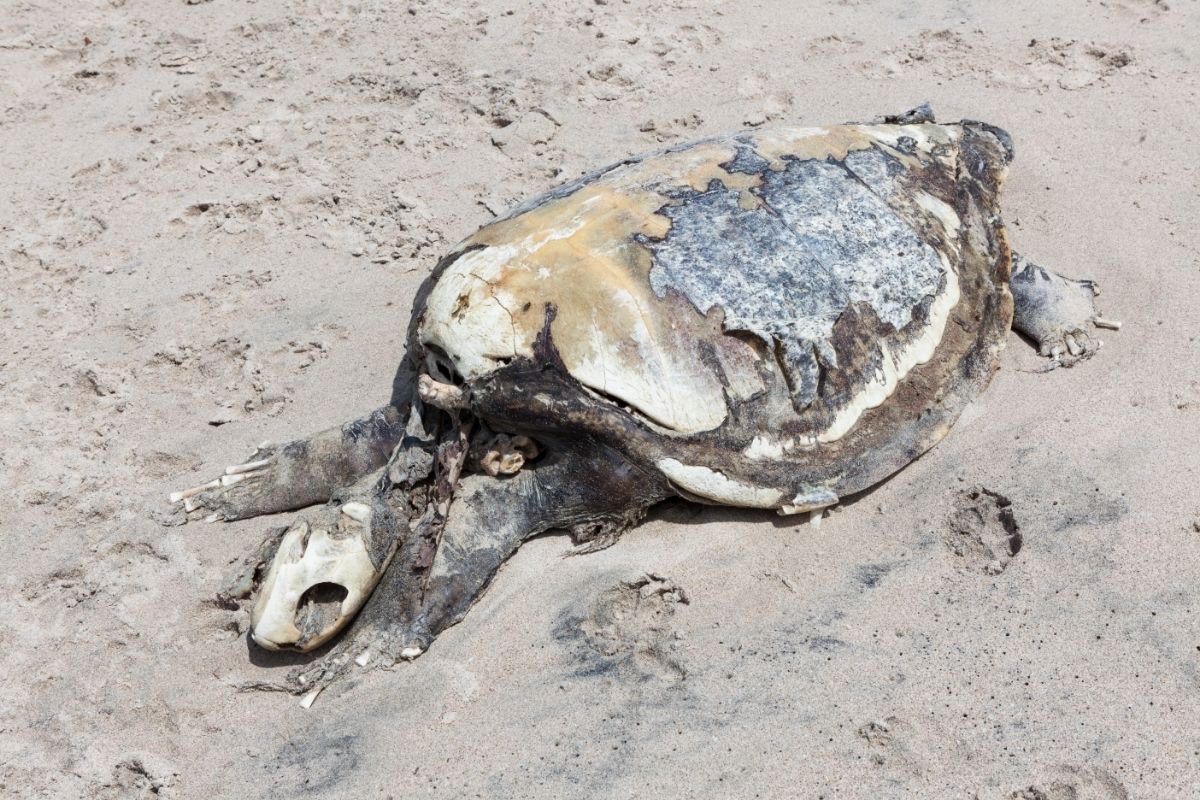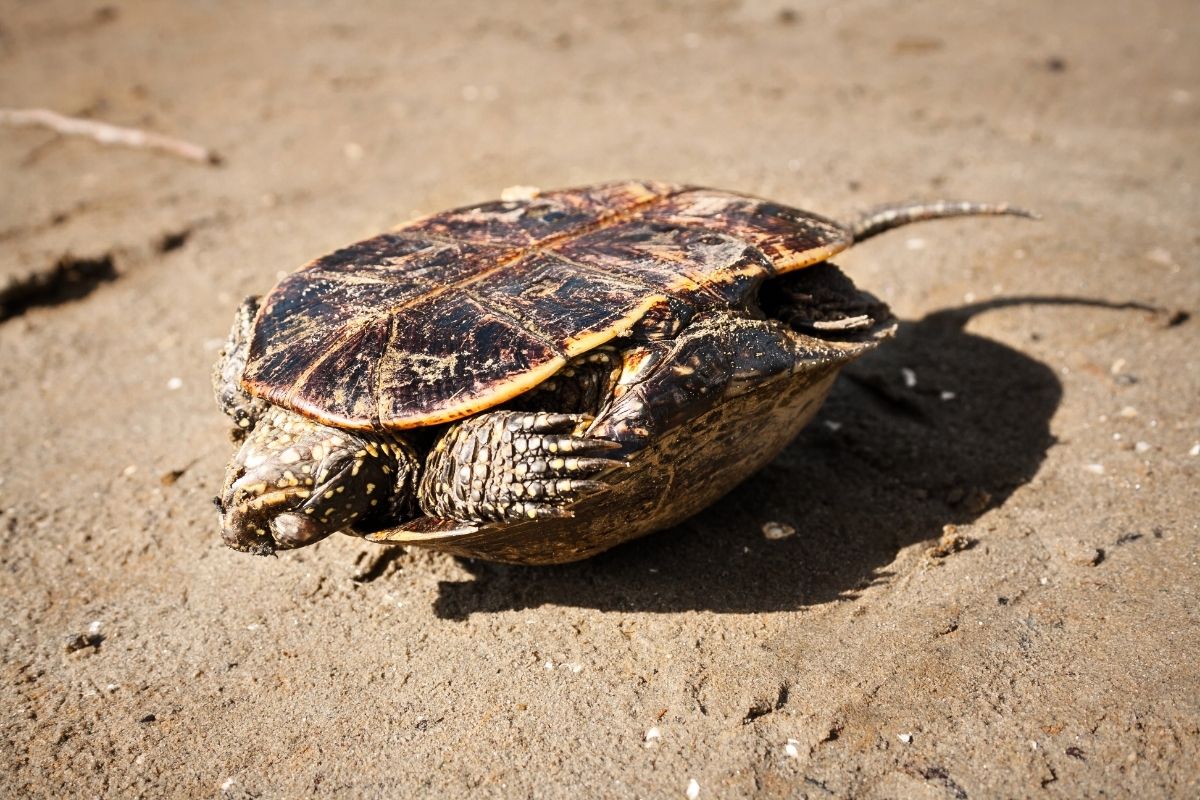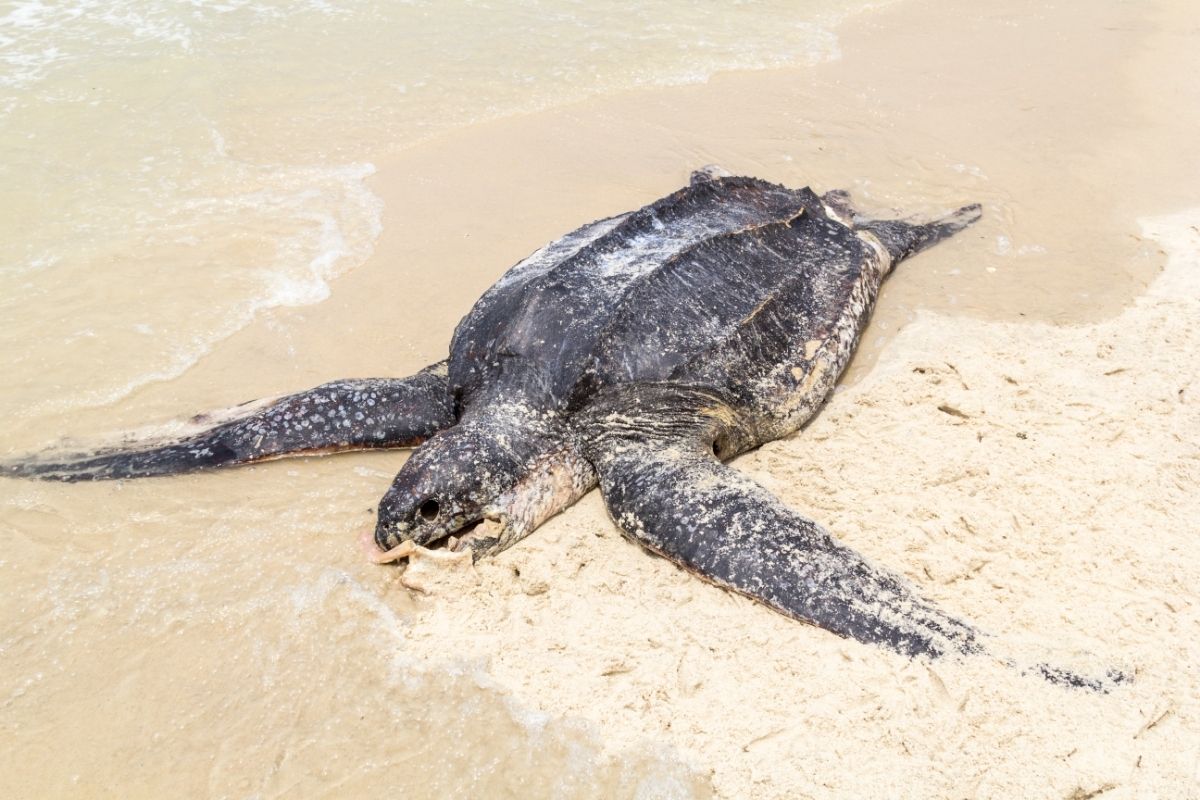There can be several indicators of a dead turtle, but you should still take the time and effort to check if it is dead. The main signs to look out for include a lack of movement and a lack of response to stimulation.
A turtle that is dead should also float on the water, not flip over whenever placed on its back, and emits a foul odor.

It could be that your turtle is simply brumating, so may be slow to respond or seem inactive. If not, the decomposition process will start quickly, and you may want to know what happens when they die.
In this guide, we will look at the telltale signs of a dead turtle and how the decomposition process occurs.
The Telltale Signs Of A Dead Turtle
Alas, all pets must die at some point in time which is a sad but realistic certainty. While turtles can live to a ripe old age of around 80, it may be difficult to recognize the signs that they have passed on.
Turtles benefit from a shell that keeps their body out of sight yet that also means it may prove difficult to tell if your turtle has died or is simply brumating.
Brumation is the process that animals and reptiles use to hibernate and save energy. For a turtle, that will mean their body system effectively seems to shut down, so they can appear somewhat stiff and lifeless.
There are still some telltale signs that you can use to check that your turtle is brumating and is not dead.
Lack Of Response
Turtles are typically aware of the environment that surrounds them, even when brumating.
You can try stimulating them by applying pressure to their cloaca (which is where the urinary, intestinal, and genital tracts open), pulling on their legs, and, as a last resort, flipping them on their back.
With no response to any of those efforts, you can presume that your turtle has unfortunately died.
Legs Go Limp
Alongside a lack of response, a lack of movement from the legs is another indicator of death. Even a brumation turtle will still have control of its legs and other muscles.
If it is unmoving, especially with the legs sticking out of the shell, then you can try picking them up. Should the legs be swinging lifelessly without any sense of control, then the turtle is likely dead.
Unpleasant Odor
Like most creatures, including humans, a dead turtle will emit an unpleasant odor as it decomposes.
If your turtle is dead, then the decomposition process will occur relatively quickly, though if the temperature is colder anyway, then this may delay the process. Your turtle should not have a foul odor so if yours does then it may be dead.
Flies/Maggots
Flies and maggots generally find their way to a decomposing body. This is one of the more obvious telltale signs of decomposition, and an infestation can be almost a certain indicator that the turtle is dead.
There is one caveat, and that is due to brumation as a turtle with a lowered immune system can be more susceptible to injuries which then get infested with maggots.
Cold When Touched
A turtle should feel warm, so if you handle it regularly and it feels strangely cold, then this may be a telltale sign that it is dead.
However, this can be a difficult way of detecting death as the brumation process naturally lowers a turtle’s body temperature. With that in mind, use other methods to determine if your turtle is still alive and just brumating.
Sunken Eyes

A dehydrated turtle can have sunken eyes, so you may want to check if it wants a drink first. If your turtle refuses to drink or simply does not respond, then that can be worrying.
The sunken eyes are another telltale sign of death though you should try some other methods of checking first.
Sunken/Shriveled Skin
You can tell a lot simply by looking at a turtle. If their skin looks sunken, shriveled, or loose, then this can be a sign of decomposition. This rarely happens for a brumation turtle, so this may be a sign of death.
Rotting
A turtle should have a well-maintained shell and skin, so if they seem to be rotting with few signs of life, then this is another indication of decomposition.
If the shell feels soft, then this may indicate brumating, which is another reason to try some other methods to check if your turtle is still alive.
The Decomposition Process
You should be checking in with your turtle every day to ensure it remains fed as well as fit and healthy.
If your turtle has died, then you should note that the decomposition process occurs quickly, and the first sign will likely be an unpleasant odor. There are five stages in the decomposition process.
Fresh
When the turtle’s heart stops beating, the ‘fresh’ stage begins. This is where the turtle can either warm up or cool down to match the temperature of the surrounding environment.
If the turtle is placed in a cool room, then the decomposition process can be relatively slower compared to when in a warm setting.
Bloating
The unpleasant smell is largely a result of the bloating stage. Gasses accumulate in the turtle’s abdominal area, which will cause it to bloat. If the turtle is placed in water, it should float due to that bloating.
Initial Decaying
After the unpleasant odor, the active decay stage can happen within a couple of days or a few weeks, depending on the surrounding environment.
The turtle’s cadaver will begin to wither, and that unpleasant odor will entice insects and maggots.
Advanced Decaying
An infestation of maggots and flies is a telltale sign of decomposition, and once they begin feeding on the turtle then, you can assume that advanced decay has begun. This stage can last for more than a few months.
Drying
Following the advanced decaying and the infestation, the only remains of your turtle will be some flesh and its dry bones and shell. Over time, the flesh will disintegrate, and the corpse will begin to dry out.
How To Deal With A Dead Turtle

Once you have determined that your turtle has died, then you may want to dispose of the remains. Should you not want to save the shell, there are other means of proper disposal.
You could simply bury the turtle in the backyard and give your beloved pet a proper burial yet this may not be possible in your region so check with local ordinances.
The veterinarian clinic could also take care of the remains though you may also contact animal control or a taxidermist.
Whatever you do, do not just throw your deceased turtle into the garbage like a lot of cities will not permit it. A veterinarian can give your pet cremation or just dispose of the remains properly.
A taxidermist may even be interested in your deceased turtle, and animal control agencies will likely take in deceased animals as part of the services they offer.
Final Thoughts
A lot of turtle species can live from ten to 80 years, so it can come as a shock when your beloved pet shows signs of decomposition and death. There are several telltale signs to look out for, including bloating and evidence of decay.
When you suspect that your turtle has died, you should first check for signs of brumation though if it remains inactive and you see an infestation of maggots and flies, then it is likely that the decomposition process has begun.
If your turtle has died, then you should dispose of it properly at a veterinarian clinic, with animal control, or with a taxidermist.
Frequently Asked Questions
How Do You Preserve A Dead Turtle’s Shell?
If you want to preserve the memory of your dead turtle, then you can keep the shell. First, remove the remains of their tissue and flesh, as it can take over a year to disintegrate.
To quicken up the process, you can wrap the turtle in a plastic bag then give it a shallow grave in the ground or store it in a metal drum to retrieve after a month or so.
One of the most effective ways to speed up the decomposition is to use cadaver-cleaning beetles, which taxidermists use to clean the bones of deceased animals.
How Do I Check If My Turtle Is Still Alive If It Feels Cold?
If your turtle feels cold and is not moving, then chances are it may still be alive. There are several ways to check that it is not yet dead, and you will not need to take it to the veterinarian.
First, as with any creature, check if the turtle is breathing as a brumating or sluggish and inactive, the turtle would still breathe yet very slowly.
Use a piece of paper or a feather placed in front of their nose, and if your turtle is still breathing then the paper or feather should show signs of movement.
You may have to show some patience, as it can take a few minutes to determine whether the turtle is breathing or not. If it proves difficult to check the breathing via the nose, then try their cloaca.
Should the turtle continue breathing, you should see the cloaca pulse, which can also take a few minutes.
With evident signs of breathing, you can try to warm your turtle up and sense some more signs of life.
Simply place the turtle in an appropriately-sized tub then fill it with water at room temperature up to around halfway up their shell then leave it to warm up for around 15 minutes to half an hour.
After that time, you should see a more vibrant turtle and more signs of life, such as your turtle moving, urinating, or defecating.
None of these methods may work, yet your turtle could still be alive. For a final and definitive verdict, take the turtle to a specialist reptile veterinarian who will be able to perform some checks and properly examine your turtle.
If the turtle is simply sick, cold, or inactive, the reptile veterinarian should know and be able to treat it.
